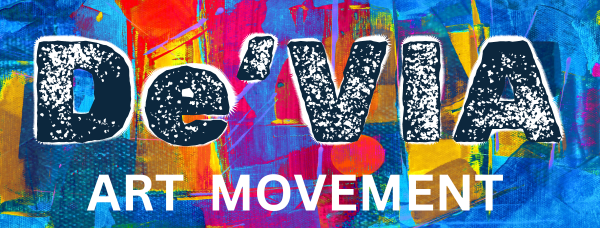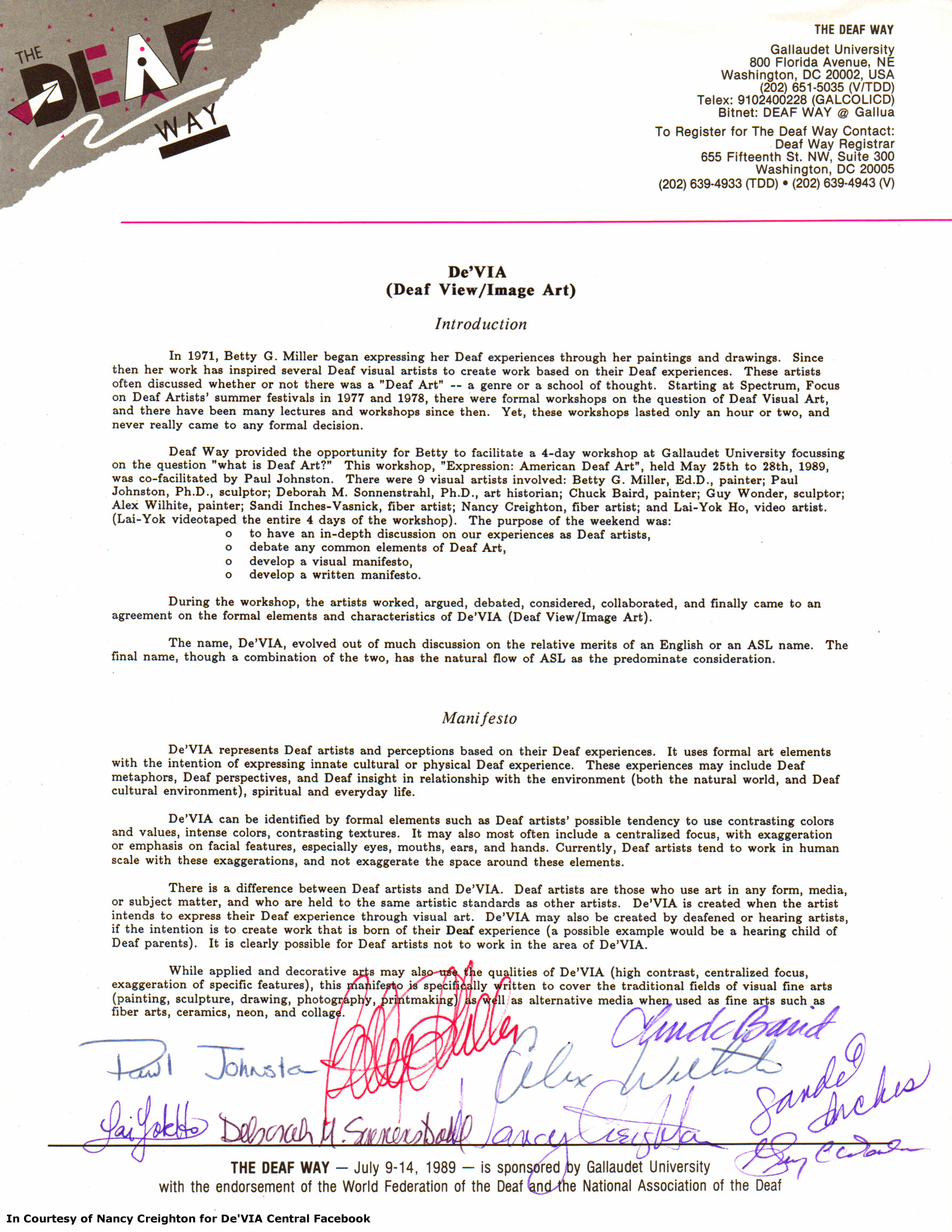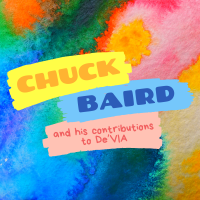
The De'VIA Art Movement
Deaf people are often drawn to visual communication. Art has always been a way for both artists and consumers of art to express themselves and connect in a meaningful way. Artists created artwork about the Deaf experience prior to the De’Via movement, but it was not until 1989 that this art genre became recognized and was organized in a thoughtful way by leaders in the Deaf artist community.
What is De’VIA?
The term De’VIA stands for Deaf View / Image Art. It was coined by a group of Deaf artists in 1989 at the first International Deaf culture festival at Gallaudet University, called Deaf Way.
De’VIA is an art movement formed by Deaf artists to express their Deaf experience (Deaf perspectives, Deaf insight, Deaf metaphors). It uses specific artistic strategies (color contrast, centralized focus) and innate cultural or physical Deaf experiences. It was the start of an art movement and the naming of the specific genre of art.
The group of artists who founded De’VIA wrote a manifesto defining it.
Excerpt from the De’VIA manifesto on what De'VIA is:
"De’VIA represents Deaf artists and perceptions based on their Deaf experiences. It uses formal art elements with the intention of expressing innate cultural or physical Deaf experience. These experiences may include Deaf metaphors, Deaf perspectives, and Deaf insight in relationship with the environment (both the natural world and Deaf cultural environment), spiritual and everyday life."
In addition to creating the name and defining it through a manifesto, the founders created a mural to be a visual statement of the De'VIA manifesto.

Original De'Via Mural created by founders of the art movement in 1989 as a visual statement of the De'VIA manifesto.
Where did the name De’VIA come from?
The name De’VIA comes from ASL. The English translation is Deaf View / Image Art. The term also looks French in appearance, perhaps a subtle homage to ASL’s French origins.
Excerpt from “De’VIA: Investigating deaf visual art” by NTID Professor Patricia Durr about the name De'VIA:
"The nine Deaf Artists not only engaged in the important act of naming the art form, they also generated the name based on ASL and created an acronym to give the feeling of a foreign language. According to art historian Deborah Sonnenstrahl, “the signs are as follow in sequence: DEAF-BLOW UP (visual image) ART. Alternatively, it has been signed DEAF-VIEW (sign DEAF then ’SEE from eyes to handshape of image’) ART. The handshape that represents the painting is the ‘image’” (Sonnenstrahl, 1996:132). Betty G. Miller, often referred to as the mother of De’VIA, signs Deaf View / Image Art following the latter description and rather than the former. However, most generally refer to it simply by fingerspelling De’VIA:
The abbreviation itself is an act of resistance by trying to create a totally new term that would reflect the meaning in the spirit of ASL rather than in English, the language of dominant culture. This sets the tone for what De’VIA is about—bringing the hearing paradigm of deafness under the Deaf artist’s gaze. Hence, this tiny, unique term was created to shatter the political cultural construct of deafness by the “other” and signified a shift in artistic consciousness from object to subject (Durr, 1999:15)."
The Founders of De’VIA
Betty G. Miller and Paul Johnston lead the four-day workshop, "Expression: American Deaf Art," where the manifest was written and the term was coined. Betty G. Miller is known as the Mother of De’VIA for spearheading the movement. Chuck Baird is known as the Father of De'VIA not only for being one of the founders, but also for contributing a large body of work to the De'VIA genre and helping to teach and mentor others.
The nine people that founded De’VIA and the Manifesto are:
- Betty G. Miller, painter
- Paul Johnston, sculptor
- Deborah M. Sonnenstrahl, art historian
- Chuck Baird, painter
- Guy Wonder, sculptor
- Alex Wilhite, painter
- Sandi Inches Vasnick, fiber artist
- Nancy Creighton, fiber artist
- Lai-Yok Ho, video artist

Copy of the De'VIA Manifest signed by the founders at Deaf Way
De'VIA Themes
There are two main themes found across De’VIA artwork — affirmation and resistance.
Affirmation De’VIA
Affirmation De’VIA celebrates Deaf culture. It highlights the positive perspective of Deaf life, Deaf culture, Deaf community, and American Sign Language. Affirmation De’VIA messaging includes empowerment, ASL, affiliation, acculturation, acceptance, and Deafhood.
Resistance De’VIA
Resistance De’VIA challenges Deaf oppression. It is the opposing theme of the De’VIA art movement and showcases how Deaf people have been marginalized. Resistance De’VIA messaging includes audism, oralism, mainstreaming, cochlear implants, identity confusion, and eugenics.
Both of these themes show the Deaf point of view and highlight the Deaf experience.
Is De'VIA Deaf Art?
Yes and no. Deaf Art describes all art about the Deaf experience (De’VIA), but it is also an all-encompassing term for any art created by a Deaf artist. De’VIA does NOT include all artwork created by any Deaf person — the artwork must specifically be about the Deaf experience. De’VIA is also not limited to only Deaf artists, as long as the artwork is about the Deaf experience. The subject matter of the artwork (being about the Deaf experience) is what defines art as being part of the De'VIA genre.
Multiple Waves of De’VIA
First Wave
The first 20 years of De’VIA, from 1989 to 2009, are considered the first wave of De’VIA. Many artists created De’VIA works during this time, but some of the most significant De’VIA artists were Betty G. Miller, Chuck Baird, Guy Wonder, Susan Dupor, Harry Williams, Tony MacGregor, and Ann Silver.
Second Wave
The second wave of De’VIA began around 2009 when artist Nancy Rourke began to explore Deafhood, and French Deafblind artist Arnaud Balard created the Surdism Manifesto without knowing De’VIA and its similar manifesto already existed.
Several artists began to use De’VIA for activism. Some notable ARTivists are Nancy Rourke, David Call, and Ellen Mansfield. The second wave of De’VIA calls for ARTivism, encouraging artists to use their art to promote social change.
A mural was created in 2013 as a visual statement of the second wave of De'VIA. It was created by over 30 artists attending a De'VIA retreat. It is permanently displayed in the Kansas School for the Deaf.

Mural created in 2013 representing the second wave of De'VIA.
Teaching About De’VIA: The De’VIA Curriculum
The De’VIA Curriculum project started in 2013 and was founded by Surdists United, Inc. Surdists United is a non-profit organization that works to promote Deaf artists, support art educators from Deaf schools and programs, and create national K-12 curriculum for Deaf Students.
Statement from the De'VIA Curriculum on the purpose:
“The founding principle of the De’VIA Curriculum is that Deaf and Deaf-blind children are entitled to learning about their Deaf heritage, language, struggles and victories, identity and rights via visual arts. With this curriculum they will also learn about traditional elements and principles of art that reinforce national art education standards. This curriculum can be used with Hearing children as more and more public schools are incorporating De’VIA into their American Sign Language (ASL) programs and other subject area curriculum.”
De’Via Curriculum provides a wealth of information on De’VIA and includes lesson plans, classroom materials, and more. For more information, see De’Via Curriculum: https://deviacurr.wordpress.com
More on Deaf Artists
Books About Deaf Artists
You can find these books on Amazon:
- Ann Silver: Deaf Artist Series (2023) by James W. Van Manen
- Nancy Rourke: Deaf Artist Series (2023) by James W. Van Manen
- Chuck Baird: Deaf Artist Series (2022) by James W. Van Manen
- Ann Silver: One Way, Deaf Way (2012) by James W. Van Manen
- Deaf Artists in America: Colonial to Contemporary (2003) by Deborah M. Sonnenstrahl
- Chuck Baird 35 Plates (1993) by Chuck Baird
Resources
- De’VIA. (2022, July 21). In Wikipedia. https://en.wikipedia.org/w/index.php?title=De%27VIA&oldid=1099611949
- Durr, P. (2006). De'VIA: Investigating deaf visual art. Deaf Studies Today! Conference, Orem, UT. Retrieved from https://scholarworks.rit.edu/cgi/viewcontent.cgi?referer=&httpsredir=1&article=1424&context=article
- Surdists United, Inc. (n.d.). 1989 Original De’VIA mural. https://deviacurr.wordpress.com/devia-curr/murals/1989-original-devia-mural/
- Surdists United, Inc. (n.d.). 2nd Wave of De’VIA Mural 2013. https://deviacurr.wordpress.com/devia-curr/murals/2013-mural/
- Surdists United, Inc. (n.d.). Welcome to De’VIA Curriculum! De’VIA Curriculum. https://deviacurr.wordpress.co
- Surdists United, Inc. (n.d.). What is De’VIA. De’VIA Curriculum. https://deviacurr.wordpress.com/devia-curr/what-is-devia/
- Surdists United, Inc. (n.d.). Supporting Deaf Artists. De’VIA Curriculum. https://deviacurr.wordpress.com/resources/supporting-deaf-artists/
Signing Savvy is a participant in the Amazon Services LLC Associates Program, an affiliate advertising program designed to provide a means for sites to earn advertising fees by advertising and linking signingsavvy.com to Amazon properties. That means Signing Savvy may contain affiliate links. If you make a purchase after clicking on an affiliate link, your cost will be exactly the same regardless, but Signing Savvy will automatically receive a small commission. Your support is greatly appreciated and helps us continue to improve Signing Savvy!
ADVERTISEMENTS
 Marta Belsky is Deaf and a third generation ASL user. She has been teaching ASL for over 35 years and enjoys sharing her native language with new users. She has a Bachelor's degree from Gallaudet University and a Masters in Deaf Education from Western Maryland College. She has taught ASL at multiple universities, coordinated interpreter services at a major university, and is a co-owner of Signing Savvy.
Marta Belsky is Deaf and a third generation ASL user. She has been teaching ASL for over 35 years and enjoys sharing her native language with new users. She has a Bachelor's degree from Gallaudet University and a Masters in Deaf Education from Western Maryland College. She has taught ASL at multiple universities, coordinated interpreter services at a major university, and is a co-owner of Signing Savvy. Chuck Baird and His Contributions to De’VIA
Chuck Baird and His Contributions to De’VIA Living Loud: Chuck Baird - Artist and Founder of De'VIA
Living Loud: Chuck Baird - Artist and Founder of De'VIA What is American Sign Language (ASL)?
What is American Sign Language (ASL)?







